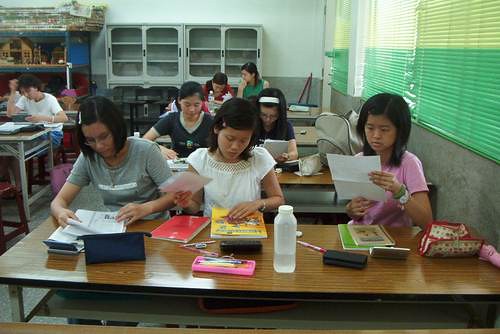Yet some cram schools (buxibans) would at times bend even those limited requirements for the right candidate. Doing so was illegal, but the demand for instructors of English as a second language (ESL) often outstripped supply as the industry grew at a torrid clip. From 2003 to 2008, the number of cram schools more than doubled from 6,000 to 12,500, according to the Ministry of Education (MOE). In the Taipei area, most qualified teachers preferred to work in the city or nearby suburbs accessible by subway. A bit farther afield, schools couldn’t afford to be picky.This article is years behind the curve. Feiren, one of the more acute observers of things Taiwan, observed back in 2010....
.....
Growth has slowed as well. Between 2008 and 2016, the number of buxibans expanded from 12,500 to 18,500, half the rate of the preceding five years. Since 2016, growth has been flat.
“Business has been tough for a while,” says Jocelyn Lu, director of the test-prep and study abroad consultancy Cambridge Taipei. In recent years, student enrollment at Cambridge Taipei has been dropping 10-15% per year on average. Profit margins are razor thin, especially after the company felt the need to reduce its tuition fee by almost one-third.
But I did find stats on the number of teachers here with work permits and was surprised to learn that in 1992 there were just 1,500 teachers here on work permits. Now at that time they had just begun issuing work permit and residence cards to teachers and most teachers still flew to Hong Kong every six months. But as late as 2000 there were still only 3,800 foreign teachers legally residing in Taiwan. That figure peaked in 2004 at 6,831 and stayed above 6,000 until June of this year when it declined to 5,749. In October there were 5,946.That was Feiren writing in 2010. You can see why the 2003-2008 period saw an "expansion" of bushibans, which at that time was more like the swelling of a corpse, for the market had already been killed. Household incomes had less money to put into education after 2009, and of course under Ma worker incomes receded back into the 1990s. The "expansion" thus took place in a market with a stable population, meaning that while there were more schools, they had fewer students.
...
Another interesting set of figures from the MOE is the percentage of household income that can be allocated to education. The average figure peaked at around NT$48,000 in 2004 and decline to NT$42,500 in 2009. There was a drop of more than 10% in 2008. That tracks the declining number of English teachers over the same period by almost the same amount c. 11.5%.
"Razor thin" profit margins had been around for a while, for I noted the death of the market back in 2005 (Yes, this blog has been around that long) because of the emergence of perfect competition in the market in the 1990s, a common phenomenon across small businesses in Taiwan....
As the chains proliferated, the size of schools began to shrink rapidly. It is now the case that around large elementary schools in Taiwan there may be a dozen or two English schools, each serving only a few score students. Essentially a situation of perfect competition has arisen in the market, where producers are small relative to market size, prices are equal to marginal cost and marginal revenues, and everyone knows the market well. Schools must struggle to keep costs down if they want to stay alive. Growth is difficult, for if the market increases anywhere, another school will quickly open to subdivide the market. Teacher pay is a major cost component for schools. With competition intense, and everyone facing the same cost structures, it was inevitable that teacher pay should become identical and stagnant within local markets.I was explaining why teacher pay hadn't budged in a decade (and is still stagnant). But at that time it was already possible to see the trend, with falling birth rates, stagnant household incomes, and rising income inequality.
The reason the bushiban market boomed in the 2003-2008 period, then fell off, is probably related to money returning from China via legal and gray/black channels. Cram schools are ideal ways to launder money and gangster investment in cram schools and in legal private schools is common, and of course, many a legal dollar was seeking business opportunities at home. That 2003-2008 period that AmCham refers to was the peak of the Chen Shui-bian era boom in Taiwanese investment and profit in China. Many people invested in cram schools because they had always been a steady earner, and because entry and exit were easy, and there was a widespread perception that they were cash cows (many of my relatives were urging me to open a cram school with them, easy money!), even though all the numbers said otherwise.
Now the market is saturated (the most saturated area for cram schools is not Taipei but Chiayi). No one I know plans to open a cram school....
_______________________
[Taiwan] Don't miss the comments below! And check out my blog and its sidebars for events, links to previous posts and picture posts, and scores of links to other Taiwan blogs and forums!

The fact that this pantomime of educaton is so embedded in the culture is mystifying.
ReplyDelete